Table of contents
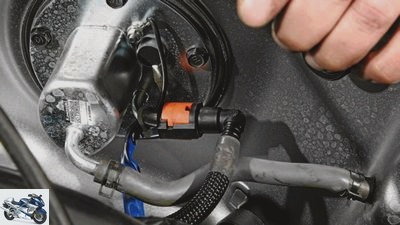
Schermer
counselor
workshop
Workshop guide: hoses and clamps
Workshop guide
Hoses and clamps
To ensure that air, fuel and coolant get exactly where they belong, hoses have to do their job in the best possible way. Perseverance is required, which in turn is part of the range of tasks of the clamps. Read here how the screwdriver handles both parts.
Klaus Herder
10/27/2010
The elementary function that a tank ventilation system that conducts air and a really closed cooling circuit have for the well-being of the engine is only noticeable when the screws are screwed incorrectly. How to avoid mistakes:
Hoses
There are many hoses on motorcycles that are laid in a visible or invisible manner. The most popular is the gasoline hose, followed by coolant hoses and hoses for tank ventilation. There are other hoses between the tank and the engine, such as B. on the intake air pressure sensor or one that connects the radiator nozzle and the coolant expansion tank. Enduros with a carburettor have a few long hoses attached to the carburetor housing to ventilate the float chamber and vent the space above the throttle valve.
- Important: All hoses, regardless of whether they transport gasoline or cooling water or are used for ventilation of the tank, the carburetor and also the engine compartment, must be “round” throughout, so they must not have a kink at any point. This is particularly important for the tank ventilation hoses. These must lead from the bottom of the tank over the engine down into the open air (Fig. A) and must not be in contact with the exhaust pipe or drag on the chain.
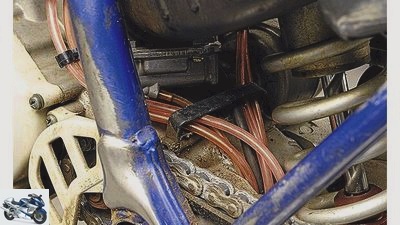
Schermer
Image A: Lay hoses without kinks, avoid hot components and grinding points.
- Small wire clamps are often found on petrol and ventilation hoses: press both ends together and guide them away from the clamping point, then pull the hose off the socket. The assembly is done in reverse.
- Pulling the hose off the socket: If you want to dismantle a hose and pull on it, it will be lengthened, but it will not slip off the socket for a long time because it is “glued” to it. Therefore, first push the hose off a little with a pair of pliers or a wide screwdriver (Fig. B) and thus loosen it from the seat on the socket, only then can you really pull it off.
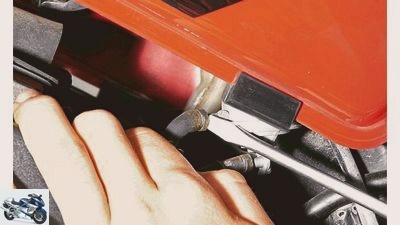
Schermer
Image B: Loosen stuck hoses a little with a screwdriver before pulling them off.
- Cooling water hoses on old motorcycles are literally “baked up” on their sockets, this is due to the hardened limescale residue (from the “wrong” because lime-containing) cooling water: grab the hose at the connection point by hand and turn it, it cracks easily, then you can get it pull it off.
- And something else important: Please be careful which hose is pushed off which nozzle; because hoses are often of different thicknesses, so that they only fit on the nozzle intended for them. It is best to mark in color with a fiber pen before peeling off.
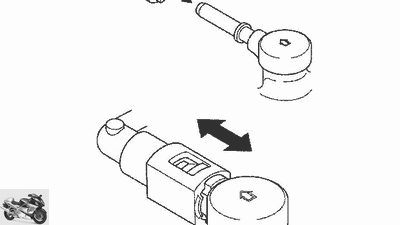
Schermer
Image C: Fuel hose quick coupling: Disconnect by pressing in the latch.
- Petrol hose coupling: Petrol hoses of modern motorcycles, whether with carburettor or injection, are attached to the tank with a quick coupling (Fig. C). With modern quick-release couplings, gasoline does not leak after disconnection, so they lock themselves off. However, you should not rely on this and always place a thick, absorbent cloth underneath when dismantling the tank and when disconnecting the fuel hose coupling.
- Caution: When dismantling and reassembling the tank and assembling fuel hoses DO NOT USE OPEN FIRE, DO NOT SMOKE!
- How to use a quick coupling: To disconnect, push in or pull out the latch (Fig. C / D), then pull off the coupling piece. When assembling, make sure that the coupling piece is pushed all the way together, it must click slightly.
Ring
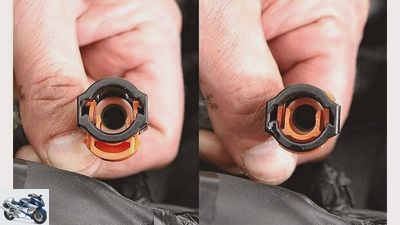
Schermer
Image D: Quick-release coupling with which a latch has to be pulled out to disconnect.
- Hose clamps: Hoses are usually secured with so-called “hose clamps” (Fig. E). The screws in the hose clamps with which z. B. Radiator hoses are clamped onto pipe sockets, must not be tightened too much, otherwise the clamp cuts into the radiator hose and it will leak at this point. Clamp screws are tightened by feeling, but there are also regulations for this, e.g. B. in workshop manuals or repair instructions.
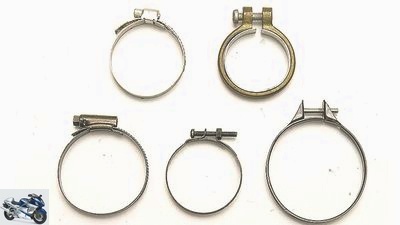
Schermer
Image E: When replacing clamps, ensure that they are of the correct type, do not over-tighten.
- The standard hose clamps are slightly rounded at the edges so that the cooling water hoses are not cut when tightened. If you can no longer get standard hose clamps for your (old ?!) motorcycle from the brand dealer, you can get some from the radiator manufacturer (yellow pages, telephone directory). He also has new radiator hoses in stock in all possible sizes.
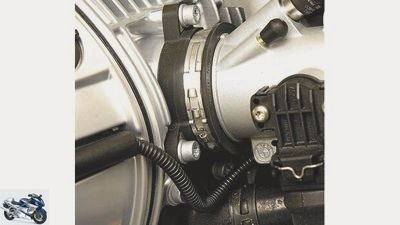
Schermer
Image F: Never replace the carburetor clamps with clamps of a different type.
- If for any reason cheap clamps must be used, check that their side edges are sharp or rounded before installing. With sharp edges, there is a risk that the radiator hose will be damaged at the clamping point when tightening, which is not immediately apparent at first glance, but the hose will tear at this point over time and then burst. If you only have hardware store hose clamps on hand, then deburr the edges with emery and “round off” them.
- Clamps: Only special carburetor clamps should be used for all clamping points of the carburettor and throttle valve housing in the rubber intake manifold on the cylinder head (Fig. F). When using water hose clamps or even those from the hardware store, the intake port is squeezed away from the carburetor port when the screw is tightened, and the engine then draws in air.
Related articles
-
Photos: Franz Josef Schermer counselor workshop Workshop guide Workshop guide – provisional Recognize botches on the motorcycle Recognize botches on the…
-
Workshop guide: install small indicators
Schermer accesories Workshop guide: install small indicators Workshop guide: install small indicators Flasher conversion on a motorcycle Mini indicators…
-
Workshop guide for plastic repairs
Dentges 13th pictures Dentges 1/13 Dentges 2/13 Dentges 3/13 Dentges 4/13 Honda Fireblade with retrofit fairing: cheap and good too? Dentges 5/13 Repair…
-
Mona Pekarek 10 pictures 1/10 2/10 3/10 4/10 5/10 6/10 7/10 8/10 9/10 10/10 counselor workshop Guide to downtime and petrol Guide to downtime and petrol…
-
Guide: Technology – engine lubrication
BILLION counselor workshop Guide: Technology – engine lubrication Guide: Technology – Motors and Drive Everything about engine lubrication To ensure…
-
Advice: workshop – repair ignition box
Ury accesories Advice: workshop – repair ignition box Guide: workshop Repair ignition box Ignition control failure can be surprisingly expensive – but it…
-
Workshop – screwdriver tip for the inspection
Ralf Petersen 15th pictures Ralf Petersen 1/15 Every motorcycle must be serviced regularly if it is to function properly. Ralf Petersen 2/15 What is…
-
Tuning and conversion guide Suzuki GSX-R 1000
Andreas Feulner 15th pictures Feulner 1/15 Performance and electronics – in these areas Suzuki has neglected the GSX-R 1000 badly. Nevertheless, it is…
-
TuneUp 2.0 Tuning and Conversion Guide Honda Fireblade
Ines Mannl 17th pictures Ines Mannl 1/17 Don’t worry, it has to be that way! Even if this Honda is not ready to drive, it all serves a higher goal!…
-
Tech Team’s Monkey Garage workshop
Blacksmith 26 pictures Blacksmith 1/26 Blacksmith 2/26 … almost to the handbag. Blacksmith 3/26 With the handlebars down, it mutates .. Blacksmith 4/26…